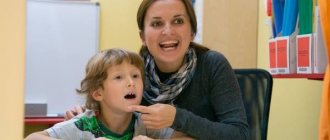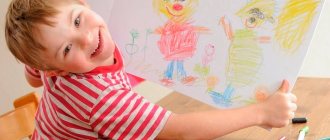- home
- Speech disorders
OHP level 2 is a clear violation of speech development in children with normal levels of intelligence and hearing, in which decreased abilities for verbal communication are observed.
The abbreviation OHP stands for general speech underdevelopment. The preschooler speaks in single words and short phrases, making a lot of grammatical errors. Common sentences are not present in speech, the active vocabulary is extremely poor. Simultaneously with violations of the lexical structure, disorders of phonemic hearing and articulation are observed.
Professor of the Research Institute of Defectology R. E. Levina dealt with issues of ONR. Based on her scientific works, correctional programs for children with speech pathologies are being developed today.
Causes
The characteristics of level 2 OHP indicate the polyetiological nature of the speech defect. That is, physical, biological and social prerequisites become the culprit for the development of the disorder. The main provoking factors are:
- fetal hypoxia;
- Rh conflict between mother and child;
- birth asphyxia;
- head injuries received at birth and in the first year of life;
- infections with neurotoxicosis;
- perinatal encephalopathy;
- pedagogical neglect;
- communication deficit;
- heredity
- separation from home, or hospitalism syndrome.
Often, OHP is a consequence of a complex of causes. This is important to consider when diagnosing and correcting a speech defect.
Symptoms
General speech underdevelopment of level 2 is characterized by the following symptoms:
- The child is diagnosed with ADD (age-related delay in speech development).
The first words appear by 2 years, the phrase after 3 years. By the age of 4, the baby constructs a sentence of 3-4 words, in most cases, without coordinating the grammatical forms of the lexemes with each other.
- Pronouns, prepositions, and conjunctions are rarely used.
- The accent is placed erroneously, most often on the last syllable.
- It is easier for a preschooler to list the names of objects and phenomena than to compose a text from these words.
- Numerous mistakes are made in the gender endings of verbs, nouns, and adjectives. The neuter gender is not perceived at all.
- When answering questions, the preschooler uses the initial forms of verbs and nouns in the nominative case.
- There are mixtures of numerical categories.
- Up to 4-5 years of age, a child with level 2 OHP helps himself with gestures and amorphous words.
- In complex words, the syllable structure is disrupted. The baby rearranges syllables and drops them. No word formation skills.
- Sound pronunciation defects in words. In this case, the isolated phoneme is pronounced clearly.
- In 70-80% of cases, kindergarteners with level 2 OHP have concomitant diseases: dysarthria, ADHD, mental retardation, paresis of articulatory muscles.
Numerous problems with extended speech lead to difficulties in understanding the baby’s statements. This can cause alienation, isolation, reluctance to take part in group games, or perform poetry at matinees in preschool educational institutions. That is, verbal, psycho-emotional contact with society is disrupted. Although there are no communication problems at home, parents understand the child’s speech and gestures.
Diagnostics
A comprehensive examination of a preschooler with speech disorders is carried out. Conclusions from a speech therapist, neurologist, and child psychiatrist will be required. The OHP diagnostic route consists of several stages:
- A conversation with parents to collect anamnesis and find out the possible cause of the speech defect.
- Assessing the level of development of a child’s speaking skills.
- Exclusion or confirmation of concomitant diseases, developmental delays.
- Studying the structure of the speech apparatus to detect organic disorders.
The final diagnosis is made based on the conclusion of the consultation. To send a child to a speech therapy kindergarten, it is necessary to undergo a PMPK. The commission must submit a reference for a preschooler from a preschool educational institution or from a psychologist. They will have a conversation with the child and parents and give recommendations on subsequent education. The program of individual work in accordance with the requirements of the Federal State Educational Standard will be drawn up by a teacher of the educational institution.
Treatment of OHP is a labor-intensive process. You cannot rely only on preschool teachers; be sure to do extra work at home, talk to your child more and listen to his statements.
General concept of OHP
OHP is a speech disorder that belongs to the pedagogical and psychological classification. Such children have completely normal hearing and intellectual abilities, but there is a clear disturbance in the speech system. Children with OHP include a completely silent child, and children who are characterized by babbling pronunciation of words, as well as children who have understandable phrasal speech, but the phonetic direction of the word is poorly developed.
The manifestation of various speech defects has very standard manifestations. In such children, the first words are formed by about three to four years, and in rare cases, by five. Speech is characterized by agrammatic sound and incorrect phonetic design. It is very difficult to understand such children, although often they perfectly understand the questions asked of them.
Due to the fact that such a child develops complexes, from a psychological point of view, it is necessary to eliminate such defects at the first manifestations.
These speech defects negatively affect the sensory, intellectual and volitional aspects of the child’s character. Such children are unable to fully concentrate their attention on a particular subject, and their normal memory ability is also affected. They cannot remember instructions given, as well as sequential tasks.
Correctional work with children with special needs development is aimed at developing analysis, comparison and generalization. Somatic weakness is reinforced by defects in motor activity, which is manifested by impaired coordination, reduced speed of movement and insufficient dexterity.
Correction
When drawing up a plan for correctional work for type 2 ODD, the speech therapist breaks it down into several blocks:
- Development of the skill of understanding other people's speech
- Vocabulary expansion
- Composing words
- Development of phonemic hearing
- Developing the ability to compose simple and common sentences
- Development of the skill of coherent statements on free topics
It is impossible to overcome speech defects with type 2 OSD without medical help. It is necessary to include narrow specialists in the work: a neurologist, a pediatrician, a rehabilitation specialist, a psychologist. A preschool student should receive medication and emotional support.
Let us dwell on each stage of pedagogical work separately. The given examples of exercises and tasks can be used with children aged 3-4 years and older.
Understanding other people's speech and expanding vocabulary
The two stages of speech defect correction are inextricably linked with each other. The more the baby knows words and understands their meaning, the better he understands the meaning of what the interlocutor said.
The main goal of classes to develop communication skills is to establish contact between the student and the teacher (speech pathologist, speech therapist), and expand the preschooler’s passive vocabulary. You can realize your planned goals faster if you use visual examples and situations that the child can understand. Be sure to include facial expressions and gestures with your words.
There is no need to devote special time to developing the skill of understanding someone else's speech. Use any pretext to speak to your child: ask for help, bring something, comment on routine moments.
Here are some examples of such situations:
- Children going for a walk
The teacher turns to them and commands: “First we put on tights, then blouses...”. At first, you can show things and help with choosing an item from the box.
- Requests
“Bring the ball”, “Pick up the cube”. Gradually, the requests become narrower: “Take the blue book on the top shelf,” “Show me where the doll in the red dress sits.”
- Putting toys in their places
The bear will sit on the sofa, the bunny will lie in the crib, and the cubes will be on the table.
To distinguish word forms, use paired pictures:
- Singular and plural verbs, nouns
The fish swim - the fish swims.
- Verb tenses
Masha is eating soup, Masha will eat soup, Masha has eaten soup.
- Case forms of nouns
The baby puts on a fur coat. The fur coat hangs in the closet.
- Possessive pronouns, adjectives
My sock, daddy's sock. Here you can use requests: give me your pencil, give Mashin a pencil.
- Spatial concepts
They help to attract the use of prepositions. The ball lies on the table, under the table, near the table. Use requests: place a book on your lap, under a chair, by the bed.
Replenish your vocabulary with the help of speech therapy lotto on different topics: “Animals”, “Seasons”, “Fruits”, “Vegetables”, “Transport”. Learn not only the names of objects, but also the verbs associated with them.
For example, when discussing a topic about animals, ask your child: is it wild or domestic, what size is it, what color is it, what does it eat, etc.
Learning to form words
It is difficult for a preschooler with level 2 OHP to say words affectionately, that is, to add suffixes to them - enk-, -k-, -onok- and others. Let's do the following tasks:
- Big small.
Watermelon-watermelon, hare-rabbit.
- Add a prefix.
He ate, ate, said and told. It is important to pay attention to changes in the lexical meaning of the word.
Games in pairs are effective for learning the composition of a word. For example, children should “argue”: I have a nose - and I have a nose, I have a house - and I have a house. The competitive element adds a touch of fun to the work process.
Development of phonemic hearing
An important component of speech therapy work to eliminate defects in stress placement and sound pronunciation. At the initial stage, you need to show children the variety of sounds in nature: rustle paper, squeak, listen to the howl of the wind, birdsong, the sound of water. Seek help from musical instruments (drums, violin, metallophone). The child must distinguish and name not only the source of the sound, but also feel its volume and melody. Hand out cards with pictures of instruments, children try to depict what it sounds like.
The next stage is distinguishing speech sounds:
- What is the difference between the nouns mouth-cat, porridge-Masha?
The preschooler must name the sounds that do not match.
- Similar word forms.
I’ll beat you and I’ll give you a roll.
- Wrong echo.
The student must repeat the word after the teacher, changing 1-2 sounds. For example, I carry - I bake, daughter Masha - daughter Glasha.
Making proposals
Start your practice with simple phrases of 2 words: I came, I put on my fur coat, I like compote. Gradually teach your preschooler to compose sentences with 3 members. You can use the following type of tasks:
- What is he doing?
Print out pictures of children playing sports, walking or harvesting. The preschooler's task is to tell what he sees, but come up with several actions for one character. For example, Masha stands on the stairs and collects pears. Vanya, Katya, Vova are walking. It is important to select homogeneous predicates or subjects.
- What?
We select complements to the predicate from the picture. For example, the Boy draws (what?) a house, a mushroom, a hedgehog.
- I have.
Children are given objects (fruit, toys, books) 2-3 per hand. Everyone must tell what they have. “And I have a coloring book, pencils, paints. And I have a mouse, a doll and a mushroom.”
- Restore the correct word order.
The speech therapist pronounces a set of words: sculpts, mouse, Masha. The students should be able to: Masha sculpts a mouse.
- Detailed answers to questions.
What are you doing? What does mom like to do? What do you see outside the window?
I draw the sun, my mother loves to sing and dance, I see puddles and trees outside the window.
Be sure to spend time developing memory and attention. Use the games “Find the odd thing in the picture”, “Who can find the object faster” (hidden in a group or in the picture), “Find the mistake”. The last game is played like this:
- The teacher says a sentence and deliberately makes a grammatical error in it.
For example, Masha and Vanya were picking pears from a tree.
- Children must repeat the sentence and be able to find and correct the mistake.
When composing and pronouncing words and sentence phrases, pay attention to the emphasis and articulation of the student. Don’t be afraid to stop, correct, ask to pronounce the correct version.
We develop coherent speech, the ability to compose your own statement
Conduct classes on developing independent speech skills in the form of a friendly conversation. Offer students the following tasks:
- Describe the picture.
- What has changed outside the window?
- Who wore what today?
- Retelling the text you heard. You can ask leading questions and rely on illustrations.
- Restore the sequence from the pictures.
- Conjugate pronunciation.
Use stories in special moments. Children voice the process of dressing for the street: first I will put on my pants, then my boots, and tie my hat. At the same time, ask questions: what color are your socks? What kind of hat does Lena have (knitted, fur)? Do you have nice shoes?
For the first 3-4 months, it is recommended to conduct individual lessons, then children are grouped in groups of 2-3 people. When preschoolers make contact with a speech therapist and a speech pathologist and are not shy about speaking and answering questions, you can move on to mass games and frontal questioning. Reinforce interest in activities with praise, surprises, and games. The lesson should last no more than 15 minutes, since children with OHP are weakened and suffer from low performance.
Include dynamic breaks in your classes to relieve physical and emotional stress. This could be finger exercises, warming up the torso.
Characteristics of the problem
OHP is a speech impairment in which children with normal hearing and relatively good memory experience poor development of the syntactic, grammatical and phonetic components of the speech system.
This is due to the fact that all components of speech develop in a narrow relationship, and if any component has not received sufficient growth, then there is a failure in the progression of the entire speech system. The speech of children at stage 3 is limited, and the forms of words they use in everyday life are incorrect.
Preschoolers do not really understand why it is necessary to learn spoken language, since it is too difficult and at some points seems boring. Therefore, oral speech is severely impaired, with a limited vocabulary that includes a small number of adjectives and words of definition. Often it becomes incomprehensible. First-person narration, without which the material being studied cannot be fully assimilated, is a difficult task and sometimes impossible.








